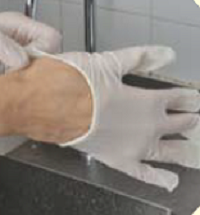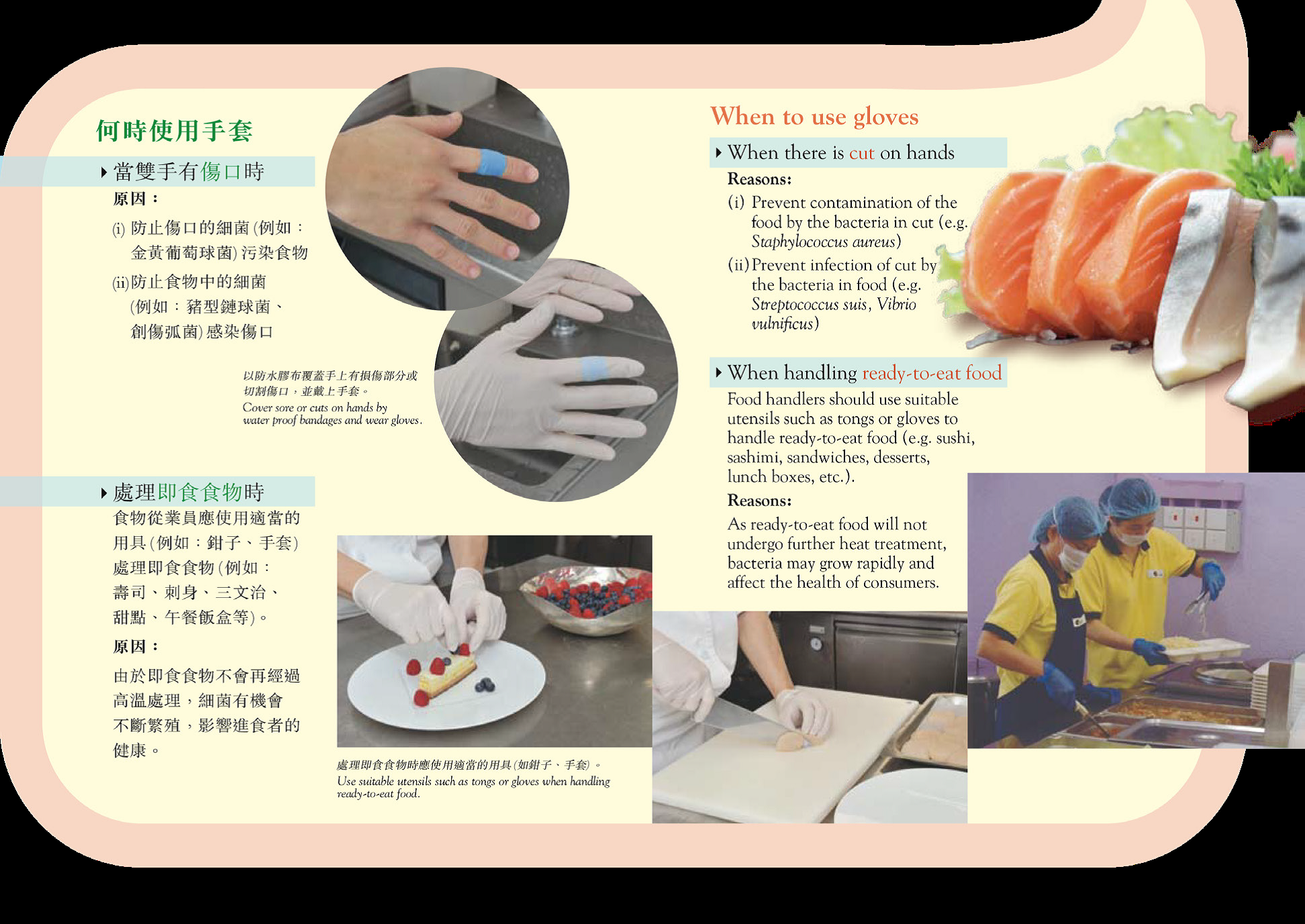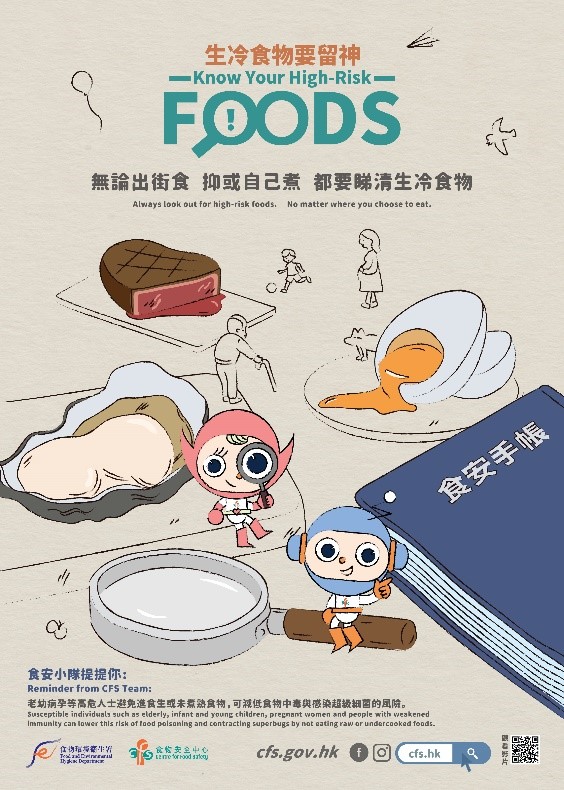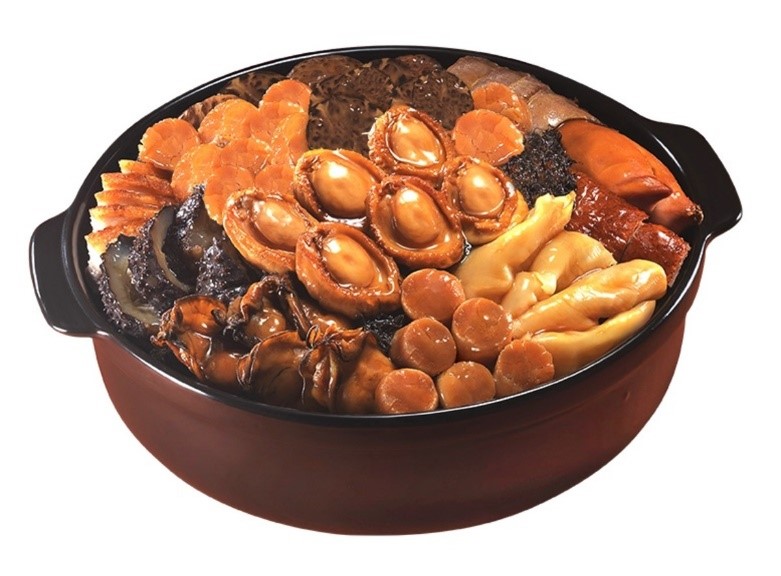
Feature Article
Food Poisoning Caused by Salmonella in Sandwiches Containing Eggs
Sandwiches are popular food items. They can be easily prepared with a wide variety of ingredients. Have you ever paid attention to the food safety issues relating to the consumption of sandwiches?
Food Poisoning Outbreak
In May 2020, there was a large-scale food poisoning outbreak involving a local brand of sandwiches. A total of 99 cases were reported with 236 persons affected. According to the Centre for Health Protection of the Department of Health, the victims suffered from abdominal pain, vomiting, diarrhoea and fever after consuming egg-containing sandwiches purchased from different retail shops in Hong Kong. Of the people affected, 51 were admitted to hospitals, including one requiring intensive care. Stool specimens of 37 affected persons were tested positive for Group D Salmonella. Two egg-containing sandwich samples taken from a retail outlet were also found to contain Salmonella.
Causes of Food Poisoning
Field investigations in the food factory and retail outlets concerned revealed that a number of factors might account for the food poisoning outbreak, including:
- cross-contamination of cooked ingredients by raw ingredients as they were handled on the same working table;
- inadequate hand hygiene facilities as food handlers shared the same towel for drying hands throughout the day without replacement;
- prolonged exposure of packed sandwiches to improper holding temperature. The packed sandwiches were delivered to retail outlets in various districts in Kowloon and the New Territories West in the morning round and then to the Hong Kong Island in the afternoon round, all the way carried by a single vehicle without any temperature control facilities. Sometimes, unsold sandwiches were transported between retail outlets for replenishment of stock, thus further increasing the delivery time; and
- improper storage and labelling of finished products. During investigations, sandwiches in a retail outlet were found stored in refrigerators at temperatures between 19℃ and 20.7℃. There was also no expiry date or production date on the package of the sandwiches for reference by the staff or customers.
Measures to Reduce Food Poisoning Risks Posed by Sandwiches
As a rule of thumb, sandwiches delivered to retail outlets or placed in storage should be kept out of the temperature danger zone (i.e. 4°C to 60°C) to limit the growth of microorganisms during transport and storage. Sandwiches left at room temperature for more than four hours should be discarded. When preparing food, food handlers should maintain hand hygiene and handle raw and cooked food separately to avoid cross-contamination.
After learning the incident and the investigation findings, the Centre for Food Safety (CFS) has instructed the food factory and the retail outlets to immediately stop the sale of all affected sandwiches. The CFS has arranged health education on food safety and hygiene for the staff concerned and requested them to clean and disinfect the affected premises thoroughly. It has also issued press releases urging the public not to consume the sandwiches in question. No new cases were reported after preventive and control measures were implemented.
Key Points to Note
- Salmonella is a common food poisoning microorganism that can cause severe illnesses.
- Sandwiches are high-risk food items because their preparation often involves manual handling. The risks of food poisoning may increase if sandwiches are contaminated by food handlers or other raw or undercooked ingredients, or stored improperly for a prolonged period of time.
- To prevent food poisoning outbreaks, food handlers should observe the Five Keys to Food Safety.
Advice to Consumers
- Patronise reliable and licensed food premises.
- Sandwiches not to be consumed immediately after purchase or preparation (including homemade ones) should be kept in the refrigerator at or below 4℃.
Readers' Corner
Rethinking on Sweeteners
Why Use Sweeteners?
The food trade uses a wide range of sugars such as sucrose (table sugar), fructose, honey and maltose for sweetening foods. The World Health Organization (WHO) recommends limiting sugar intake to less than 10% of the daily calorie intake, and proposes to lower this level to 5% or less for additional health benefits.
The food industry generally adds sugar substitutes or sweeteners with a lower sugar content to foods in lieu of sugar. Providing a sweet taste with no calories, artificial sweeteners seem to be an ideal choice for sugar reduction. However, new scientific evidence suggests that replacing sugar with artificial sweeteners may not bring about the expected health benefits. It is high time to reconsider whether we should only use sweeteners as a substitute for sugar.
What Are Artificial Sweeteners?
Artificial sweeteners (e.g. aspartame, acesulfame and sucralose) are low-calorie or calorie-free chemical substances widely used by the food industry as a substitute for sugar to sweeten foods and drinks. Food and beverage products with a lower calorie content are suitable for diabetic patients and appealing to weight watchers. For example, 1g of aspartame (providing 4 kcal) can replace 200g of sucrose (providing 800 kcal).
In Hong Kong, sweeteners approved for food uses have undergone safety evaluations by international authorities (including the Joint FAO/WHO Expert Committee on Food Additives), and are regulated by the Sweeteners in Food Regulations under the Public Health and Municipal Services Ordinance, Cap.132. Sweeteners permitted to be used in foods are acesulfame potassium, alitame, aspartame, aspartame-acesulfame salt, cyclamic acid, saccharin, sucralose, thaumatin, neotame and steviol glycosides. All prepackaged foods added with sweeteners are required to be properly labelled with the names or identification numbers of the sweeteners in the ingredient list.
Are Artificial Sweeteners Friends to Sugar Reduction Policies?
Artificial sweeteners are treated differently across different jurisdictions. Public Health England has recommended their use for food reformulation. In Singapore, sweetener-laden beverages complying with the relevant standards are credited with the Healthier Choice Symbol.
However, artificial sweeteners are less welcome elsewhere. For example, in the European Union, fruit, vegetables and milk distributed to schools must not contain sweeteners. Some European countries (e.g. France) even impose taxes on drinks added with artificial sweeteners. The Nordics ban the use of sweeteners in Keyhole products, a type of prepackaged foods identified as healthier food products under the related food labelling scheme. The US Dietary Guidelines Advisory Committee reiterates that added sugar should not be replaced with low-calorie sweeteners, and that people should make healthier choices such as drinking water instead of sugar-sweetened drinks.
Take the Bitter with the Sweet
Earlier studies showed that artificial sweeteners, if used properly, might help reduce sugar intake, thereby facilitating short-term weight loss. Nevertheless, it is of concern that people using artificial sweeteners may think that they have less calorie intake and tend to consume more other foods, hence the lost calories will be replaced through other sources. Besides, overstimulation of sugar receptors from frequent use of sweeteners may prevent people from associating sweetness with caloric intake. As a result, they may crave for more sweet food and gain weight.
Recent Studies on Health Impacts of Artificial Sweeteners
In 2019, two studies on the health impacts of artificial sweeteners pointed out that sweeteners were no magic bullets for sugar reduction and health protection. A large-scale systematic review of over 10,000 records conducted by the Cochrane group suggested that the use of non-sugar sweeteners had no significant health benefits on a range of health outcomes, including the body mass index and weight loss. Concurrently, a cohort study of over 450,000 individuals in Europe carried out by the International Agency for Research on Cancer and other institutes found that people with a daily consumption of two or more glasses of soft drinks (sugar sweetened or artificially sweetened) faced a greater risk of all causes of death compared with those who drank less than one glass per month.
Less Sugar and Sweeteners
A better approach to healthy living is to select foods and beverages with less sugar or no added sugar/sweeteners. Consumers can refer to the food labels on prepackaged foods to make informed choices. It requires joint efforts of the trade and the public to reduce sugar and sweeteners in our diet. The food trade is encouraged to reduce the sweetness of food by using less sugar and sweeteners so that the public can adapt to a lighter flavour and eventually alter their dietary habits.
Spot Check
Importance of Proper Use of Disposable Gloves in Food Handling
With the current development of the COVID-19 pandemic in Hong Kong, more and more restaurant employees choose to use disposable gloves at work. There are concerns whether disposable gloves are being properly used.
It should be noted that improper use of gloves is unhygienic and will increase the chance of cross-contamination, as gloved hands can take up bacteria like bare hands. Even worse, it will give food handlers a false sense of security against infections.
When wearing disposable gloves to handle ready-to-eat food, use clean ones to prevent contamination. One should wash hands properly before wearing and after removing gloves. Gloves intended for single use should not be reused.





Disposable gloves should be changed frequently in the following situations:
- Change of work or work station:
- If cleansing is suddenly required during preparation of ready-to-eat food, food handlers should wash their hands thoroughly and wear new gloves after cleansing to continue food preparation.
- If food handlers need to refill food during packaging of lunch boxes, they should wash their hands thoroughly and wear new gloves after taking the containers with new food before proceeding with packaging.
- When the gloves are soiled, such as:
- after touching raw food or cooking utensils
- after coughing, sneezing or blowing one's nose
- after touching the nose, hair or other parts of the body
- after eating or going to the toilet
- The gloves are torn.
- Regular replacement during work (such as every half hour or hourly).
Remember that wearing disposable gloves cannot replace hand washing. Where possible, arrange designated staff to handle food and general staff members to share other duties such as handling payment or waste and cleaning to further enhance food safety.
Updates on CFS
Food Safety Day: Eat Safe! Know Your High-risk Foods

Our smart readers may have learned from the previous issue that the CFS has adopted "Eat Safe! Know Your High-risk Foods" as the theme of Food Safety Day 2020. High-risk foods here refer to “raw and cold food”, which is a loose description of raw or undercooked food items. Some common food products may contain raw or undercooked ingredients, for examples, mango pudding with raw eggs, smoked salmon sandwiches and congee prepared with undercooked beef.
Talking about "raw and cold food", do you know that four population groups are more susceptible to these high-risk foods and should be more alert to their health risks?
What Are the Susceptible Groups?
- Pregnant women
- Infants and young children
- The elderly
- People with weakened immunity
This year, the CFS has prepared a set of leaflets titled "Know Your High-risk Foods" to raise public awareness of the risks of "raw and cold food" to the four susceptible groups, with a view to preventing food poisoning and more serious complications.
In this issue, we will discuss the safety risks of "raw and cold food" to two susceptible groups, namely pregnant women and infants and young children.
Pregnant Women
Pregnant women are more susceptible to food poisoning because their immune systems change during pregnancy and their unborn babies’ immune systems are still in development, which can increase the risk of premature delivery or miscarriage.
Infants and Young Children
Infants and young children are especially vulnerable to foodborne illnesses (also known as food poisoning) and related health complications. This is because their immune systems are still developing and they cannot fight off infections as effectively as adults. Infants and young children also produce less stomach acid to kill harmful bacteria, thus having a greater risk of infections with foodborne bacteria.
"Know Your High-risk Foods" Leaflets
- Food Safety Advice for Infants and Young Children
- Food Safety Advice for Pregnant Women
- Food Safety Advice for the Elderly
- Food Safety Advice for People with Weakened Immunity
For more information on the above, please visit the following webpage:
https://www.cfs.gov.hk/foodsafetyday/

Food Safety Day 2020
Briefing of Activities
Roving Exhibitions on Food Safety
To step up publicity on food safety, the CFS organises thematic exhibitions in shopping centres of public or private housing estates, government offices or markets managed by the Food and Environmental Hygiene Department. There are exhibition boards on various food safety and nutrition topics, including the Five Keys to Food Safety, Nutrition Labelling, Trans Fat, Organic Food, Genetically Modified Food and Natural Toxins in Food to enhance public knowledge on how to make safe and suitable food choices. The staff on site will show educational videos and distribute leaflets and souvenirs to visitors during the exhibitions.
Four roving exhibitions were held at the following venues in July and October 2020
| Date | Venue | Theme |
| 3 July 2020 | Causeway Bay Market | Nutrition Labelling |
| Genetically Modified Food | ||
| Acrylamide in Food | ||
| 9 July 2020 | New Wan Chai Market | Five Keys to Food Safety |
| Prevention of Cross-contamination | ||
| Enhance Food Traceability, Strengthen Food Safety | ||
| 6 October 2020 | Kowloon City Market | Nutrition Labelling |
| Acrylamide in Food | ||
| Trans Fat | ||
| 9 October 2020 | Sha Tin Government Offices | Five Keys to Food Safety |
| Prevention of Cross-contamination | ||
| Organic Food |
Updated arrangements of the exhibitions will be announced regularly. Members of the public are welcome to visit the following website (https://www.cfs.gov.hk/english/whatsnew/whatsnew_act/whatsnew_act.html) for more details.
For enquiries, please contact the CRU of the CFS at 2381 6096.
Upcoming Activities
Seasonal Food Health Talk - Poon Choi

"Poon choi" is a distinctive local dish popular among Hong Kong people. With the approach of autumn and winter, we will soon welcome the arrival of more traditional Chinese festivals. Many restaurants see this as an opportune time to prepare "Poon choi" or offer it for sale to attract customers. There is also an increasing number of groups interested in organising "Poon choi" feasts. As "Poon choi" has a great variety of food ingredients and its preparation is complicated and time-consuming, the food safety risks involved are relatively high. To avoid these risks, food handlers should pay attention to various risk factors when preparing the dish. In this regard, the CFS presents food safety talks on the preparation of "Poon choi" for the trade every year. Restaurants will receive an invitation letter and an enrolment form listing the dates, time and venues for the talks. Members of the trade are welcome to take an active part in these events.
Video recordings of talks previously organised by the CFS are available at the following website:
https://www.cfs.gov.hk/english/multimedia/multimedia_vrt/index.html

Video recordings of talks
For enquiries, please call the CRU of the CFS at 2381 6096.
Food Safety Q&A
Natural Toxin in Fresh Jin Zhen
Truth Against Fallacy
Can I Avoid Washing Hands by Using Gloves to Handle Ready-to-eat Food?
Wearing gloves is an acceptable way to minimise direct hand contact with ready-to-eat food. However, improper use of gloves may increase the risk of cross-contamination as gloves, like bare hands, can become contaminated with bacteria. Gloves are only beneficial when new ones are used for each activity and food handlers take care when changing them. Washing hands thoroughly is actually the best way to prevent contamination of food by hands.
Key Points to Note
(1) Wearing gloves cannot substitute hand washing and good personal hygienic practices.
(2) Improper use of gloves is as unhygienic as inadequate hand washing.
(3) Assign different staff members to handle food and perform other duties, such as handling cash and cleansing.
Brain Gym
Please put the following food items into the refrigerator by referring to food safety rules:
- sushi
- raw pork
- cake
- frozen chicken wings
- vegetable
- fruit

Ans
- c
- a
- b, e, f
- d
Enquiries and Subscription
Printed copies of the Food Safety Bulletin can be obtained from the Communication Resource Unit at Room 401, 4/F, Food and Environmental Hygiene Department Nam Cheong Offices and Vehicle Depot, 87 Yen Chow Street West, Sham Shui Po, Kowloon. For enquiries, please call 2381 6096.